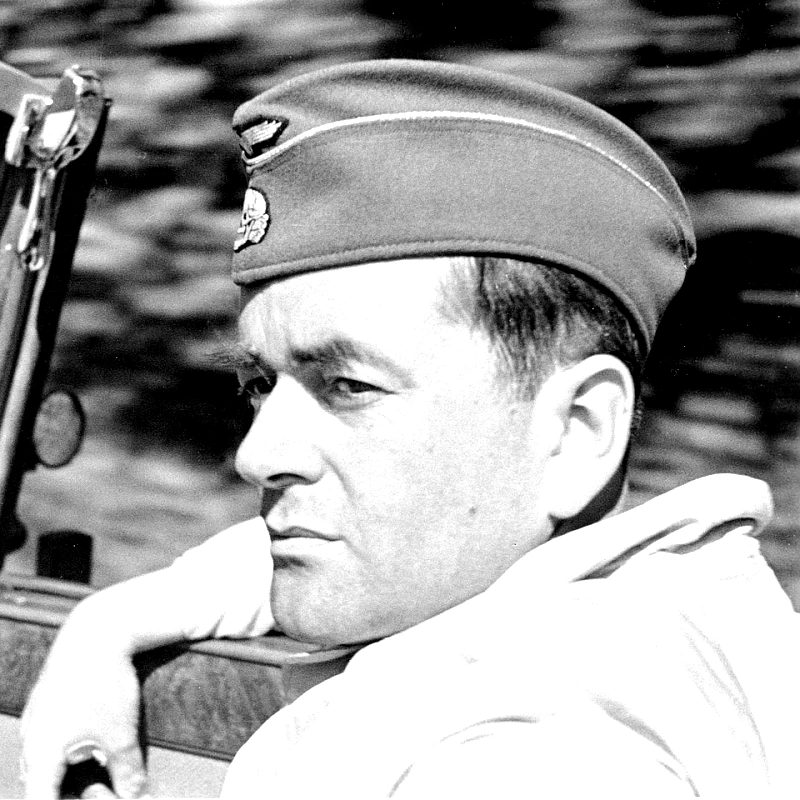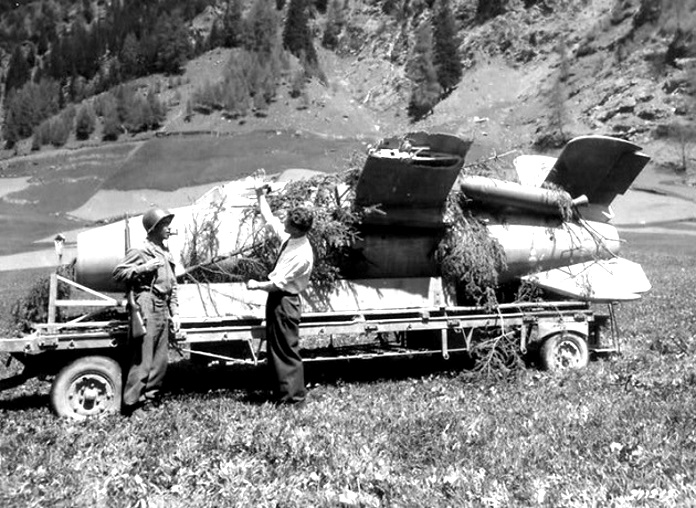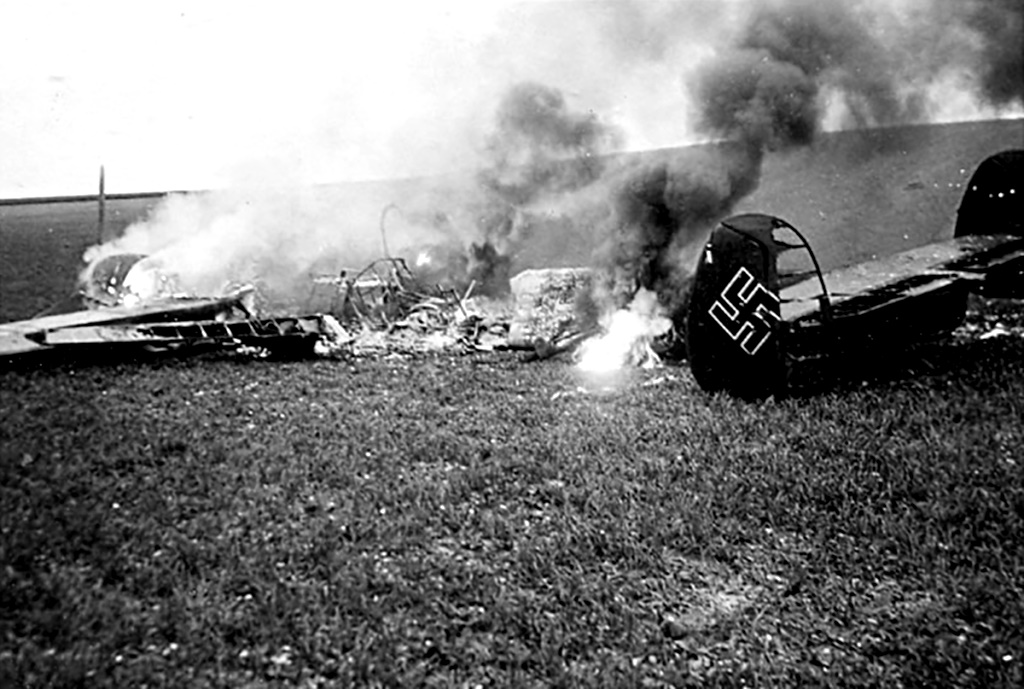Question: What countermeasures did this inaugurate in: a. Disposition of available forces; b.Modification of aircraft types and armament?
a.The immediate countermeasures should have been a vast increase in fighter strength. In December 1943, however, Hitler would hear nothing which savored defensive warfare and actually ordered that fighter strength should be reduced in favor of HE-177 production. It was not until June/July 1944 that this incredible decision was reversed and an attempt to increase fighter strength was begun. b. No direct modification of aircraft types and armament resulted because types had been changing for the whole of the preceding year, ex. the 262 and 163 were already replacing single-engine fighters. These new types however were not fully operational or even fully into production by the middle of 1944 when Hitler finally agreed to increase the fighter program.
Question: What was the Luftwaffe’s calculation of the loss rate necessary to stop American Air Force bombardment?
I do not know of any figure on the German side which it was felt would be necessary to incur to terminate American bombing. On the American side it was generally felt that if we could cause the Americans a 20 percent loss, a cessation of American attacks would probably result.
Question: Why were not more intruder operations tried over American Air Force bases in England?
The reasons are fairly complicated and involve consideration of the extremely efficient fighter defense of England, British RDF (Radar Detection), and really excellent fighter control. In order to attack American bases in England, it would have been necessary for German aircraft to carry extra tanks to an extent where the superiority in the speed of Allied fighters would have become critical. With such a position obtaining, day attacks on American airfields were out of the question, and towards the end of the war, the petrol question excluded the whole possibility anyway.
Question: Were there any types of lucrative targets that we could have attacked effectively with fighter bombers that we ignored?
In my opinion, no.
Question: Did the Germans realize that the American Air Force intended to bomb by systematic selection of targets and if so, when?
We certainly realized that the Americans had definite plans for the systematic selection of targets but I cannot say when this was first realized.
Question: What objectives did they recognize?
An analysis of attacks soon showed that the main targets which were being systematically selected were oil-producing works and refineries, ball-bearing industries, and railway stations and airfields.
Question: Did the Germans ever contemplate or practice a defensive system that would concentrate on the defense of certain vital objectives only?
There was a definite defensive system for the defense of certain vital targets, ex. the concentration of ME-163 forces and heavy AA round oil-producing centers such as at Politz, which had at least 80 AA batteries. As far as I know, there was never any plan to defend certain selected targets to the complete neglect of others.
Question: When did American attacks on the aircraft industry begin to cut into production?
Prior to the summer of 1944 the effect of American attacks on the aircraft industry was mainly local and, although this had caused a certain amount of dispersal with a consequent drop in production, it was not until the beginning of the summer of 1944 that lasting effects appeared.
Question: When did the Germans realize that oil had become our top priority?
I believe the realization came in the autumn of 1943 after the attack on Ploesti.
Question: Did the change allow the Germans full recovery to a satisfactory ball-bearing position?
The ball-bearing industry was never nursed back to its original position but it was restored to something like a satisfactory position on a modified scale. The attack on Friedrichshafen exerted a very great influence on the ball-bearing position.
Question: Was there any other system (such as power, abrasives, explosives, iron, and steel, etc.) that we could have destroyed with a comparable effort that would have hit the German fighting effectiveness sooner or more seriously than the ones we chose?
There was no industry that could have been more effectively attacked than oil from the Allied point of view, primary targets from the very beginning should have been oil, oil, and more oil.
Question: What effect did the use of underground factories have on jet airplane production?
Very little effect because it was undertaken too late. The extensive building of underground factories in time would have had a very great effect.
Question: Was the operational development of jets held up by critical shortages of any kind?
Yes, certainly by fuel but also by ball-bearings and some metal parts.
 The Effects of Allied Bombing of Germany
The Effects of Allied Bombing of Germany
Minister of Armaments and War Production Albert Speer
July 11, 1945
The following information on the effects of the Allied bombing was obtained from Reich Minister for Armaments and War Production Albert Speer. The information was obtained in reply to a specific briefing which was answered in a signed statement by Speer; a full translation of this document is appended in the form of question and answer. It must be noted that when Speer refers to the German chemical industry he includes in this term the synthetic oil industry. The interrogation was carried out under the auspices of CIOS, to whose good officers and assistance all due acknowledgment is made.
Question: At what stage of the war did strategic bombing begin to cause the German High Command and Government real concern, and why?
The first heavy attack on Hamburg in August 1943 made an extraordinary impression. We were of the opinion that a rapid repetition of this type of attack upon another six German towns would inevitably cripple the will to sustain armaments manufacture and war production. It was I who first verbally reported to the Fuehrer at that time that a continuation of these attacks might bring about a rapid end to the war. At first, however, the raids were not repeated with the same weight, and in the meantime, it became possible for the civilian population to adapt themselves to these air attacks both from the point of view of morale and the experience gained, while at the same time the armaments industry was able to gather useful experience.
The raids on the ball-bearings industry at Schweinfurt in July 1943, evoked a renewed crisis, the full import of which was likewise made known to the Fuehrer in all its gravity. Here again, the delay in the development of repetitions of the attack gave us the necessary time to take defensive precautions.
The raids on the aircraft industry and tank engine factories early in 1944 caused a serious renewal of anxiety and doubt, although as it became evident in this case also that our industry was more elastic than had at first been assumed, our anxieties in this connection lessened.
In May and June 1944, the concentrated day and night attacks on the Ruhr transport and communications system first began to cause most serious anxieties about future developments, since supplies to the industry in the rest of the Reich of the numerous products of the Ruhr, ranging from coal to single items, were bottled up in the Ruhr owing to transport difficulties and could no longer be conveyed to the intended recipients. That these effects did not immediately manifest themselves was due only to the fact that industry throughout the Reich was in possession of considerable stocks of goods, and that in the case of coal it was possible to make a priority delivery for armaments and war production in the summer months at the expense of household deliveries and of the provision of stocks for the winter. A memorandum was delivered by me to the Fuehrer in June 1944 on the subject of the Ruhr and its problems.
The planned assaults on the chemical industry which began on May 12, 1944, caused the first serious shortages of indispensable basic products and therefore the greatest anxiety for the future conduct of the war. Information on this subject is to be found in the numerous memoranda addressed to the Fuehrer in June 1944, in which the further prosecution of the technical side of the war (eines Technischen Krieges) is repeatedly shown to be impossible. I had the impression that these attacks were to mark the beginning of the long-expected and long-feared series of planned attacks upon the industrial economy and moreover upon a sphere which owing to its complicated structure was particularly difficult to restore and impossible to decentralize. In actual fact, this type of attack was the most decisive factor in hastening the end of the war.
The attacks on transport and communications only produced serious consequences as their intensity increased. The communications system proved itself however extremely resistant so that in spite of the attacks an emergency transport system for the needs of armament and war production could be maintained until the late autumn of 1944. In this connection, from autumn 1944 onwards the Reichsbahn at my instigation continuously submitted written reports to the Fuehrer regarding the serious anxieties that future developments must inevitably produce.
Question: What measures were taken to deal with the threat, and how effective did they prove? Did the German High Command consider they could stop strategic bombing by these measures?
Unfortunately no energetic measures were taken in regard to fighter production. From the time of the attacks on Hamburg from August 1943 onwards, Milch, Galland and I combined to press for priority to be given to the construction of fighters and represented that their operational use within the Reich was more urgent than their deployment at the front. Nevertheless, the High Command ordered bomber production to be continued as they were of the opinion that it was only by means of retaliatory attacks that the Allied assault on German towns could be halted. This accounts for the fact that even in 1945 the construction of four-engined bombers was ordered once again!
Moreover, considerably more importance was attached to the Flak program in the battle against the bombers. From time to time and particularly from autumn 1944 onwards, the Flak program was given a higher priority than the fighter program. The Fuehrer was frequently ordering that aircraft production should be reduced in order that more Flak guns could be built but these orders were in fact incapable of realization. In addition to these active measures, after the attack on the ball-bearings plant at Schweinfurt the first steps were taken to transfer this industry to Lower Silesia and to disperse in various groups in Franconia. The dispersal of important plants following attacks upon vital points was undertaken. Furthermore, from early 1944 onwards underground dispersal was envisaged to a planned extent of 3 million square meters (of which 1.5 million square meters had been executed by February 1945). (Note: Other informants have suggested that this program for the occupation of 3 million square meters of underground floor space referred only to the aircraft industry.)
I was not of the opinion that the effects of planned air operations against industrial targets could be avoided by measures of this nature. The choice of when to deliver attacks on industrial objectives and of sustaining these raids as consistently as might be required lay exclusively with the enemy bombers. One cannot meet air attack with the slogan ‘Concrete versus Bombs’. The opponent in the air is able to choose his objectives and in so doing he can plan to concentrate on any vital target with such a weight of attack as hitherto has never been possible in the whole history of war. There was consequently no means of defense.
In spite of all this, however, the Allied air attacks remained without decisive success until early 1944. This failure, which is reflected in the armaments output figures for 1943 and 1944 is to be attributed principally to the tenacious efforts of the German workers and factory managers and also to the haphazard and too scattered form of attack of the enemy who until the attacks on the synthetic oil plants based his raids on no clearly recognizable economic planning.
Question: What effect did the taking of these measures have on the production and allocation of manpower?
Up to the year 1944, neither the air attacks nor the defense measures taken to meet them disturbed armaments production for until that time it was still possible to utilize for armament production considerable reserve drawn from the whole field of industry; in this connection, the machine tool industry was in a position to make a valuable contribution. The restoration of the industry was, moreover, made possible by the contracts and extensions which were already in course of the execution with the aim of increasing current output. The chemical industry in particular succeeded for a considerable time in satisfying its requirements of materials for rebuilding purposes by using materials earmarked for projected extensions of plants that had been abandoned. Until the autumn of 1944, the diversion of manpower to the construction work and the clearance of air raid damage had a disturbing effect on production, for up to that time there was a shortage of manpower in the industry. From the autumn of 1944 onwards, the effects of air attacks were so considerable that a rapidly increasing surplus of manpower became available. The total manpower engaged in work arising from air-raid damage can be estimated at between 1 and 1.5 million persons.
The total damage suffered by the armament programs as a result of air attack during the year 1943, was not considered. With regard to the year 1944, on the other hand, it may be assumed that on the average there was a fall in production amounting to 30/40 percent, for had it not been for the air attacks the projected output program would certainly have been achieved; the gap between the production programs and the actual output attained corresponds to this percentage.
Question: Did the effects of the strategic bombing at any time cause any of the three branches of the German High Command to modify, postpone or abandon planned operations?
I am not aware that any material alteration had to be made in the timing of a planned operation, or that any operation was abandoned on account of an air attack. The reason for this was not that the air raids had not caused material damage before such an operation began, but rather that our supreme command refused to see and to admit the consequences of such attacks. As an example of this, I can quote the beginning of the Ardennes Offensive. The attack was ordered to begin although the units had only one or two fuel supply units (Versorgungssaetze an Treibstoff); the entire supply of bridge-building equipment still lay in the rear areas, while the rest of the supply organization for the units was insufficient for the distant goal in view. Feldmarschall Model and Oberstgruppenfuehrer Dietrich called attention to this state of affairs but the timetable for the attack persisted. Without any doubt, the lack of supplies was due to the transport difficulties caused by air attacks.
 Question: Which forms of attack, at various periods of the war were most effective in weakening the German war effort?
Question: Which forms of attack, at various periods of the war were most effective in weakening the German war effort?
Only the mass attacks by day, because these were based upon economic considerations and inflicted heavy damage on precise targets. Some ‘Oboe’ (Radar Guided Bombers System) night attacks with Mosquitoes upon the Goldenberg Power Station and the August Thyssen Huette were disturbing on account of the precision with which they were carried out. The last night attack upon the Krupp works, which was carried out by a large number of four-engined bombers caused surprise on account of the accuracy of the bomb pattern. We assumed that this attack was the first large-scale operation based on ‘Oboe’ or some other new navigational system. The last series of night attacks on Poelitz, Bruex and Leuna were more effective in their results than the day attacks by reason of the fact that the superheavy bombs caused shattering damage to these plants. On the other hand, the previous night’s attacks on towns had no decisive effect on armaments output.

























